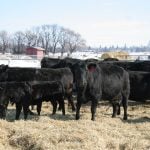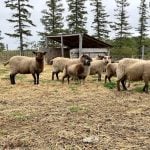ASSINIBOIA, Sask. – A quest for a better pulse crop lifter is starting to reap rewards for Dave Dietrich.
“The idea started about 1998. I had grown Milestone lentils the first year they were out. I had a really nice looking crop, close to 40 bushels per acre and I bought a new flex header to take them off,” said Dietrich, who farms near Assiniboia.
“I asked around about the best kind of lifters to put on, was told a certain kind, but when I put them on, I could see they were not designed for a flex header. I went about 100 yards (90 metres) and figured I was getting about half the lentils and pushing the rest down flat on the ground.
Read Also

VIDEO: Ag in Motion documentary launches second season
The second season of the the Western Producer’s documentary series about Ag in Motion launched Oct. 8.
“I could not find a crop lifter that would do the job to my satisfaction in pulse crops. So I began to develop what has become known as the Flexxifinger QD Pulse Crop Lifter. Originally, the idea was for my own use. I was looking for something that would work on my own farm, in my conditions.”
The Flexxifinger, which was named best new invention at this year’s Farm Progress Show in Regina, has a forward portion that lifts the crop. Behind the finger receptor, a tail sticks out over top of the guard and knife to hold the plant material above the knife until it arrives on the table.
“The piece that fits on the top of the guard, with the spring attached that slides into the quick-detach nut, is the rail,” Dietrich said.
“The spring is riveted to the rail. On the top of the guard bolt, the quick-detach nut is attached at the proper height so the rail will slide flat and slide easily into the slot of the nut, so the spring rides over the crown of the nut to snap it into place.”
The snout is on the bottom at the front of the rail. It fits over the finger of the guard to hold it in position. On top of the rail is the nose, where the finger receptor bolts on. The receptor is adjustable and allows the finger’s forward lifting point to adjust up or down.
The nylon finger has a round portion and a flattened portion. The flattened portion slides through the back of the finger receptor pipe and is twisted 90 degrees to lock it in place.
“To remove the crop lifter, you lift the back portion of the spring behind the crown of the nut high enough to clear the top of the nut and slide the rail forward. To replace it, you line up the guard finger into the snout, line up the rail so it slides into the slot of the quick-detach nut and push straight back,” Dietrich said.
Washers are used to adjust the height of the nut so the rail slides in properly. They can be added or subtracted as needed , depending on location of knife guides and other items on the header.
The finger receptor cross bolt uses a quarter-inch carriage bolt with a nylon lock nut. A 7/16 wrench is all that’s needed to adjust the finger.
“You can probably lift the forward lifting point of the finger about three inches (7.6 centimetres). If you go down to the full extent, it’s pretty steep and you wouldn’t run with it like that. You want it operating no more than two inches (five cm) down from level,” Dietrich said.
“When guys are walking around the combine to check things, they carry a 7/16 wrench in their pocket to adjust any (lifter that) needs fine tuning.”
Like most other lifters, the Flexxifinger units are attached about a foot apart, so a 30-foot header would use 29 lifters.
Dietrich said the rail will slide in smoothly and snap into place once the quick-detach nuts are installed at the proper height, and most people leave them on the header. They don’t seem to interfere with crop flow or built-up material.
While the nylon fingers are resilient and will take some abuse, Dietrich said they snap before doing any damage to the header.
“If steel lifters ever dig into the ground on a flex header, they have a tendency to grab the header and bend it back. The nylon fingers would either flick out or break off.”
Dietrich had a number of goals when he started developing a pulse crop lifter for his own farm.
“First I wanted something that was gentle on the crop, that would lift the crop up right in front of the header,” he said.
“When you’re combining pulse crops, they’re normally quite dry. If you lift them up too far ahead, I felt they were shelling out more than they needed to before they were cut by the knife and ended up on the table. So I wanted it gentle on the crop both before it was cut and after it was cut. I wanted it to hold it up above the knife even after it was cut so it would feed into the table.”
He also wanted a design that was easy to adjust, where the forward lifting point could be moved up or down.
“On ‘experienced’ headers, not all guards are pointing the same direction. I wanted to be able to fine tune that forward lifting point even an eighth of an inch if need be, in order to get the crop but not be digging into the ground.”
Easy maintenance was another priority. After a number of designs, Dietrich eventually came up with a one-piece nylon finger rather than two nylon fingers: one going forward and one backward.
He also wanted something that was easy to install and remove.
“You don’t always want crop lifters on the header. If there’s a thunderstorm threatening, it’s getting dewy, and you’re trying to combine the last few passes on the field, any kind of lifter doesn’t work really good when it’s dewy. You may want to take the lifters off in that situation before the thunderstorm hits.
“So I wanted something you could take the lifters off in a real hurry. I can pull them off of my 30-foot header in about a minute and put them back on in about three minutes.”
Dietrich also wanted them to come off easily because previous designs had forced him to remove two or three lifters from the header before he could work on a broken sickle section or guard. Now, he can quickly make the repair.
The crop lifters fit most combine and swather headers, but not all on the market.
“We probably fit 80 to 90 percent of them that are out there now. The ones with the quick cut knife, there’s no easy way to mount most lifters, because there’s no guard fingers.”
While Dietrich has been using nylon fingers on his own farm and in the development process, in 2004 he decided to let a few farmers do trials with them to see how they worked under different field and operator conditions.
“We had reports of three to eight bushels per acre improvements in downed pea crops. We learned a lot from that 2004 season, improved the product, then sold a small number of sets in 2005.”
This year Dietrich has started promoting the product a little more, attending a few trade shows.
While the lifters were originally designed for straight combining dry pulse crops, he said one farmer has tried them in hay crops and some producers have expressed interest in trying them in canola.
One customer used the lifters for trash management after a hailstorm flattened his pea crop. The customer combined the remaining peas and then tried to seed winter wheat, but there was still too much trash on the ground and his drill kept plugging. He went over the field again with the pulse crop lifters on his combine and removed enough plant material to allow the drill to seed without plugging.
Other reports include farmers saying they’ve been able to harvest both directions in a downed pea crop, while neighbours without the lifters could cut only in one direction under similar conditions.
Some farmers claim better yields and others higher field speeds when using the lifter.
Dietrich said the nylon fingers can be used with a bat reel.
“A steel lifter with a higher tail at the back can’t be adjusted low enough to wipe between the lifters. With the nylon rear portion, it just bends out of the way.”
Along with manufacturing the Flexxifinger QD lifter, Dietrich has also licensed the quick detach mechanism to the Ralph McKay Co. of Regina.
“They manufacture a spring steel lifter and they have the right to use our quick detach mechanism.”
Dietrich said he has already field tested a number of lifters that fit the quick detach mechanism.
“I take the view that we have tried to use one type of crop lifter for all types of crops. I think that’s a mistake. If we can do a better job with a specialty crop lifter for a specific type of crop, and put more in the bin, it would make sense to do that. The common denominator for that becomes the quick detach mechanism.”
Plans for 2007 include releasing a product similar to an old lifter that’s been on the market for decades, with a spring-tension system that follows the ground.
“We have a product I tested on my own combine. We call that the high cut lifter. It’s a longer lifter, but it has a nylon finger on the front to pick up sawflied wheat and durum and still cut off the ground quite a bit,” he said.
“I take the view that not all farmers would like the same kind of lifter, so they shouldn’t be forced to buy the same kind. If they prefer a different kind in their crop conditions or ground conditions, they should be able to get that, but still fit conveniently on a quick detach mechanism. So that’s what we’re working on, trying to come out with those products.”
Dietrich is developing a dealer network, but also sells from his farm. He includes all the hardware to install the pulse crop lifter, plus an additional nylon finger with every lifter, for $48.95 per unit. Replacement nylon fingers are $4 each.
“In my opinion, there’s no such thing as a perfect lifter, but if it’s a bit better, easier on the header, easy to adjust, maintain and attach or remove, I feel it has great value.”
Contact: 306-642-3451 or flexxifinger@sasktel.net.














